Lala Shakti Swarup Ray
SImpHAR: Advancing impedance-based human activity recognition using 3D simulation and text-to-motion models
Jul 08, 2025Abstract:Human Activity Recognition (HAR) with wearable sensors is essential for applications in healthcare, fitness, and human-computer interaction. Bio-impedance sensing offers unique advantages for fine-grained motion capture but remains underutilized due to the scarcity of labeled data. We introduce SImpHAR, a novel framework addressing this limitation through two core contributions. First, we propose a simulation pipeline that generates realistic bio-impedance signals from 3D human meshes using shortest-path estimation, soft-body physics, and text-to-motion generation serving as a digital twin for data augmentation. Second, we design a two-stage training strategy with decoupled approach that enables broader activity coverage without requiring label-aligned synthetic data. We evaluate SImpHAR on our collected ImpAct dataset and two public benchmarks, showing consistent improvements over state-of-the-art methods, with gains of up to 22.3% and 21.8%, in terms of accuracy and macro F1 score, respectively. Our results highlight the promise of simulation-driven augmentation and modular training for impedance-based HAR.
TxP: Reciprocal Generation of Ground Pressure Dynamics and Activity Descriptions for Improving Human Activity Recognition
May 04, 2025Abstract:Sensor-based human activity recognition (HAR) has predominantly focused on Inertial Measurement Units and vision data, often overlooking the capabilities unique to pressure sensors, which capture subtle body dynamics and shifts in the center of mass. Despite their potential for postural and balance-based activities, pressure sensors remain underutilized in the HAR domain due to limited datasets. To bridge this gap, we propose to exploit generative foundation models with pressure-specific HAR techniques. Specifically, we present a bidirectional Text$\times$Pressure model that uses generative foundation models to interpret pressure data as natural language. TxP accomplishes two tasks: (1) Text2Pressure, converting activity text descriptions into pressure sequences, and (2) Pressure2Text, generating activity descriptions and classifications from dynamic pressure maps. Leveraging pre-trained models like CLIP and LLaMA 2 13B Chat, TxP is trained on our synthetic PressLang dataset, containing over 81,100 text-pressure pairs. Validated on real-world data for activities such as yoga and daily tasks, TxP provides novel approaches to data augmentation and classification grounded in atomic actions. This consequently improved HAR performance by up to 12.4\% in macro F1 score compared to the state-of-the-art, advancing pressure-based HAR with broader applications and deeper insights into human movement.
Initial Findings on Sensor based Open Vocabulary Activity Recognition via Text Embedding Inversion
Jan 13, 2025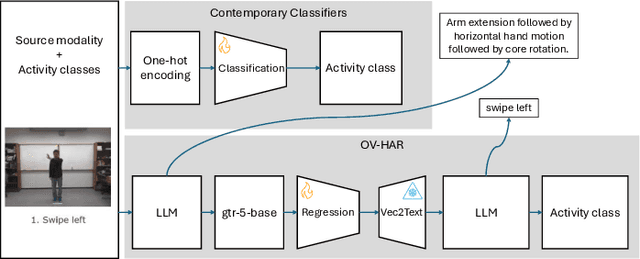
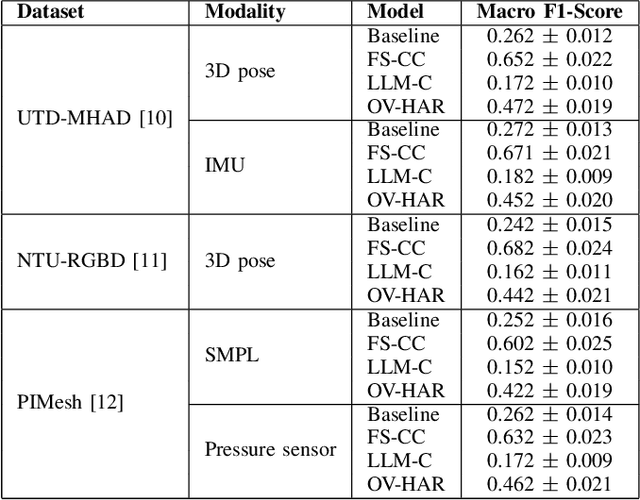
Abstract:Conventional human activity recognition (HAR) relies on classifiers trained to predict discrete activity classes, inherently limiting recognition to activities explicitly present in the training set. Such classifiers would invariably fail, putting zero likelihood, when encountering unseen activities. We propose Open Vocabulary HAR (OV-HAR), a framework that overcomes this limitation by first converting each activity into natural language and breaking it into a sequence of elementary motions. This descriptive text is then encoded into a fixed-size embedding. The model is trained to regress this embedding, which is subsequently decoded back into natural language using a pre-trained embedding inversion model. Unlike other works that rely on auto-regressive large language models (LLMs) at their core, OV-HAR achieves open vocabulary recognition without the computational overhead of such models. The generated text can be transformed into a single activity class using LLM prompt engineering. We have evaluated our approach on different modalities, including vision (pose), IMU, and pressure sensors, demonstrating robust generalization across unseen activities and modalities, offering a fundamentally different paradigm from contemporary classifiers.
OV-HHIR: Open Vocabulary Human Interaction Recognition Using Cross-modal Integration of Large Language Models
Dec 31, 2024



Abstract:Understanding human-to-human interactions, especially in contexts like public security surveillance, is critical for monitoring and maintaining safety. Traditional activity recognition systems are limited by fixed vocabularies, predefined labels, and rigid interaction categories that often rely on choreographed videos and overlook concurrent interactive groups. These limitations make such systems less adaptable to real-world scenarios, where interactions are diverse and unpredictable. In this paper, we propose an open vocabulary human-to-human interaction recognition (OV-HHIR) framework that leverages large language models to generate open-ended textual descriptions of both seen and unseen human interactions in open-world settings without being confined to a fixed vocabulary. Additionally, we create a comprehensive, large-scale human-to-human interaction dataset by standardizing and combining existing public human interaction datasets into a unified benchmark. Extensive experiments demonstrate that our method outperforms traditional fixed-vocabulary classification systems and existing cross-modal language models for video understanding, setting the stage for more intelligent and adaptable visual understanding systems in surveillance and beyond.
ALS-HAR: Harnessing Wearable Ambient Light Sensors to Enhance IMU-based Human Activity Recogntion
Aug 22, 2024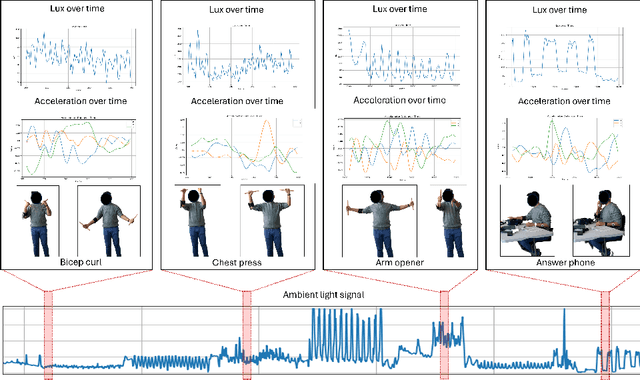
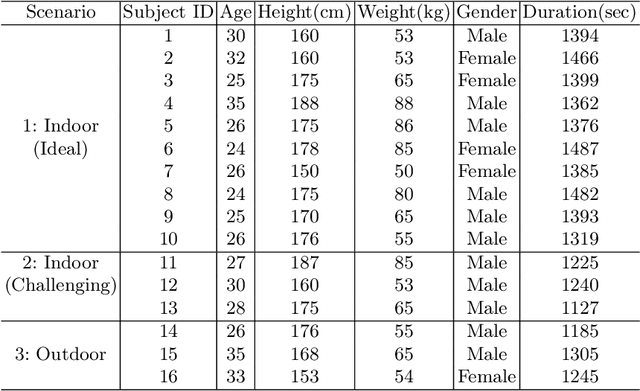
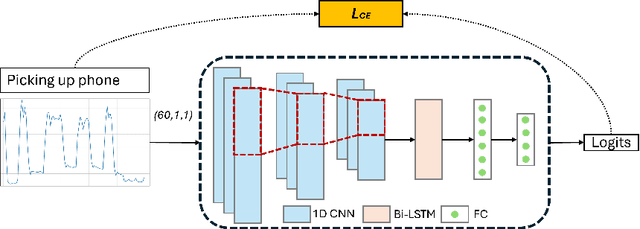
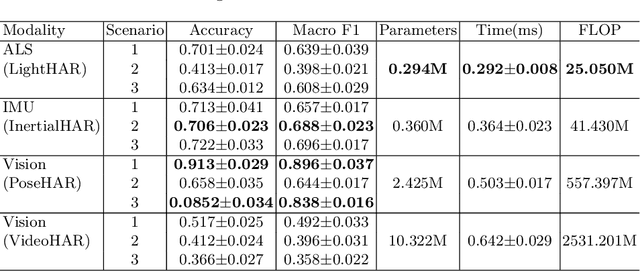
Abstract:Despite the widespread integration of ambient light sensors (ALS) in smart devices commonly used for screen brightness adaptation, their application in human activity recognition (HAR), primarily through body-worn ALS, is largely unexplored. In this work, we developed ALS-HAR, a robust wearable light-based motion activity classifier. Although ALS-HAR achieves comparable accuracy to other modalities, its natural sensitivity to external disturbances, such as changes in ambient light, weather conditions, or indoor lighting, makes it challenging for daily use. To address such drawbacks, we introduce strategies to enhance environment-invariant IMU-based activity classifications through augmented multi-modal and contrastive classifications by transferring the knowledge extracted from the ALS. Our experiments on a real-world activity dataset for three different scenarios demonstrate that while ALS-HAR's accuracy strongly relies on external lighting conditions, cross-modal information can still improve other HAR systems, such as IMU-based classifiers.Even in scenarios where ALS performs insufficiently, the additional knowledge enables improved accuracy and macro F1 score by up to 4.2 % and 6.4 %, respectively, for IMU-based classifiers and even surpasses multi-modal sensor fusion models in two of our three experiment scenarios. Our research highlights the untapped potential of ALS integration in advancing sensor-based HAR technology, paving the way for practical and efficient wearable ALS-based activity recognition systems with potential applications in healthcare, sports monitoring, and smart indoor environments.
Enhancing Inertial Hand based HAR through Joint Representation of Language, Pose and Synthetic IMUs
Jun 03, 2024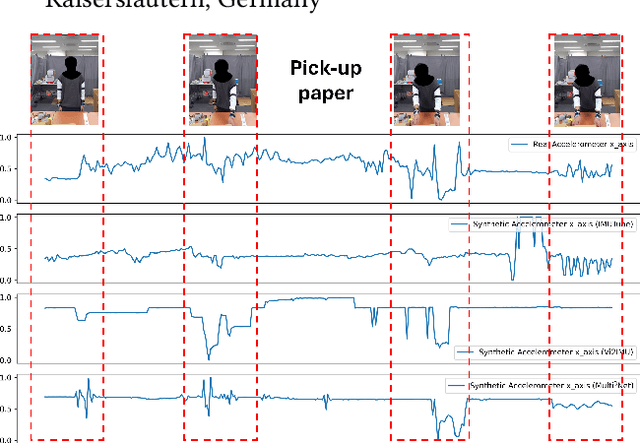
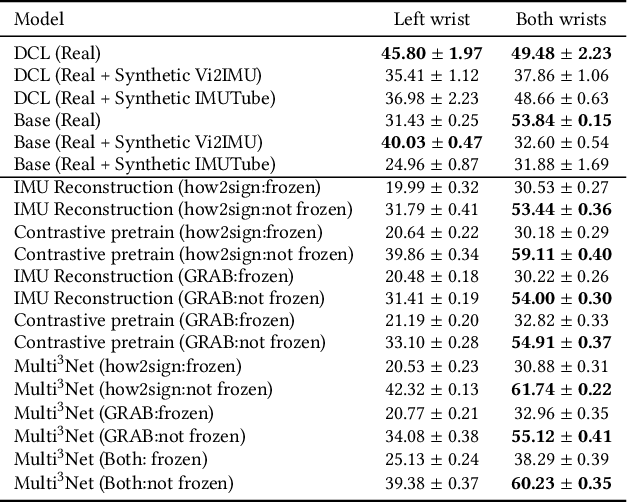
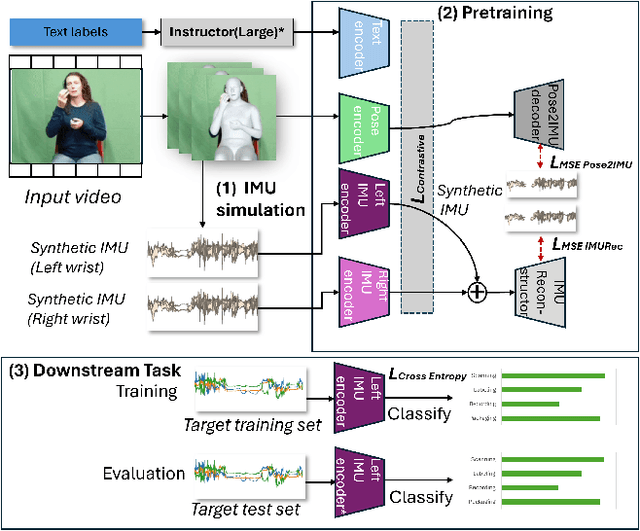
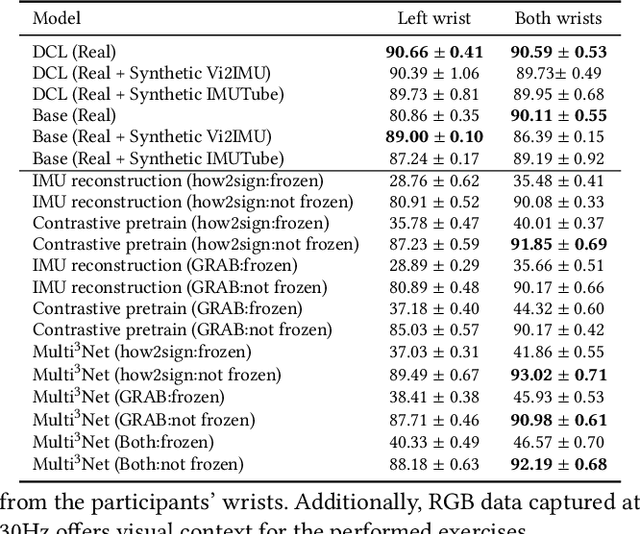
Abstract:Due to the scarcity of labeled sensor data in HAR, prior research has turned to video data to synthesize Inertial Measurement Units (IMU) data, capitalizing on its rich activity annotations. However, generating IMU data from videos presents challenges for HAR in real-world settings, attributed to the poor quality of synthetic IMU data and its limited efficacy in subtle, fine-grained motions. In this paper, we propose Multi$^3$Net, our novel multi-modal, multitask, and contrastive-based framework approach to address the issue of limited data. Our pretraining procedure uses videos from online repositories, aiming to learn joint representations of text, pose, and IMU simultaneously. By employing video data and contrastive learning, our method seeks to enhance wearable HAR performance, especially in recognizing subtle activities.Our experimental findings validate the effectiveness of our approach in improving HAR performance with IMU data. We demonstrate that models trained with synthetic IMU data generated from videos using our method surpass existing approaches in recognizing fine-grained activities.
Text me the data: Generating Ground Pressure Sequence from Textual Descriptions for HAR
Feb 22, 2024



Abstract:In human activity recognition (HAR), the availability of substantial ground truth is necessary for training efficient models. However, acquiring ground pressure data through physical sensors itself can be cost-prohibitive, time-consuming. To address this critical need, we introduce Text-to-Pressure (T2P), a framework designed to generate extensive ground pressure sequences from textual descriptions of human activities using deep learning techniques. We show that the combination of vector quantization of sensor data along with simple text conditioned auto regressive strategy allows us to obtain high-quality generated pressure sequences from textual descriptions with the help of discrete latent correlation between text and pressure maps. We achieved comparable performance on the consistency between text and generated motion with an R squared value of 0.722, Masked R squared value of 0.892, and FID score of 1.83. Additionally, we trained a HAR model with the the synthesized data and evaluated it on pressure dynamics collected by a real pressure sensor which is on par with a model trained on only real data. Combining both real and synthesized training data increases the overall macro F1 score by 5.9 percent.
A Novel Local-Global Feature Fusion Framework for Body-weight Exercise Recognition with Pressure Mapping Sensors
Sep 14, 2023


Abstract:We present a novel local-global feature fusion framework for body-weight exercise recognition with floor-based dynamic pressure maps. One step further from the existing studies using deep neural networks mainly focusing on global feature extraction, the proposed framework aims to combine local and global features using image processing techniques and the YOLO object detection to localize pressure profiles from different body parts and consider physical constraints. The proposed local feature extraction method generates two sets of high-level local features consisting of cropped pressure mapping and numerical features such as angular orientation, location on the mat, and pressure area. In addition, we adopt a knowledge distillation for regularization to preserve the knowledge of the global feature extraction and improve the performance of the exercise recognition. Our experimental results demonstrate a notable 11 percent improvement in F1 score for exercise recognition while preserving label-specific features.
PressureTransferNet: Human Attribute Guided Dynamic Ground Pressure Profile Transfer using 3D simulated Pressure Maps
Aug 01, 2023



Abstract:We propose PressureTransferNet, a novel method for Human Activity Recognition (HAR) using ground pressure information. Our approach generates body-specific dynamic ground pressure profiles for specific activities by leveraging existing pressure data from different individuals. PressureTransferNet is an encoder-decoder model taking a source pressure map and a target human attribute vector as inputs, producing a new pressure map reflecting the target attribute. To train the model, we use a sensor simulation to create a diverse dataset with various human attributes and pressure profiles. Evaluation on a real-world dataset shows its effectiveness in accurately transferring human attributes to ground pressure profiles across different scenarios. We visually confirm the fidelity of the synthesized pressure shapes using a physics-based deep learning model and achieve a binary R-square value of 0.79 on areas with ground contact. Validation through classification with F1 score (0.911$\pm$0.015) on physical pressure mat data demonstrates the correctness of the synthesized pressure maps, making our method valuable for data augmentation, denoising, sensor simulation, and anomaly detection. Applications span sports science, rehabilitation, and bio-mechanics, contributing to the development of HAR systems.
Selecting the motion ground truth for loose-fitting wearables: benchmarking optical MoCap methods
Jul 25, 2023Abstract:To help smart wearable researchers choose the optimal ground truth methods for motion capturing (MoCap) for all types of loose garments, we present a benchmark, DrapeMoCapBench (DMCB), specifically designed to evaluate the performance of optical marker-based and marker-less MoCap. High-cost marker-based MoCap systems are well-known as precise golden standards. However, a less well-known caveat is that they require skin-tight fitting markers on bony areas to ensure the specified precision, making them questionable for loose garments. On the other hand, marker-less MoCap methods powered by computer vision models have matured over the years, which have meager costs as smartphone cameras would suffice. To this end, DMCB uses large real-world recorded MoCap datasets to perform parallel 3D physics simulations with a wide range of diversities: six levels of drape from skin-tight to extremely draped garments, three levels of motions and six body type - gender combinations to benchmark state-of-the-art optical marker-based and marker-less MoCap methods to identify the best-performing method in different scenarios. In assessing the performance of marker-based and low-cost marker-less MoCap for casual loose garments both approaches exhibit significant performance loss (>10cm), but for everyday activities involving basic and fast motions, marker-less MoCap slightly outperforms marker-based MoCap, making it a favorable and cost-effective choice for wearable studies.
 Add to Chrome
Add to Chrome Add to Firefox
Add to Firefox Add to Edge
Add to Edge